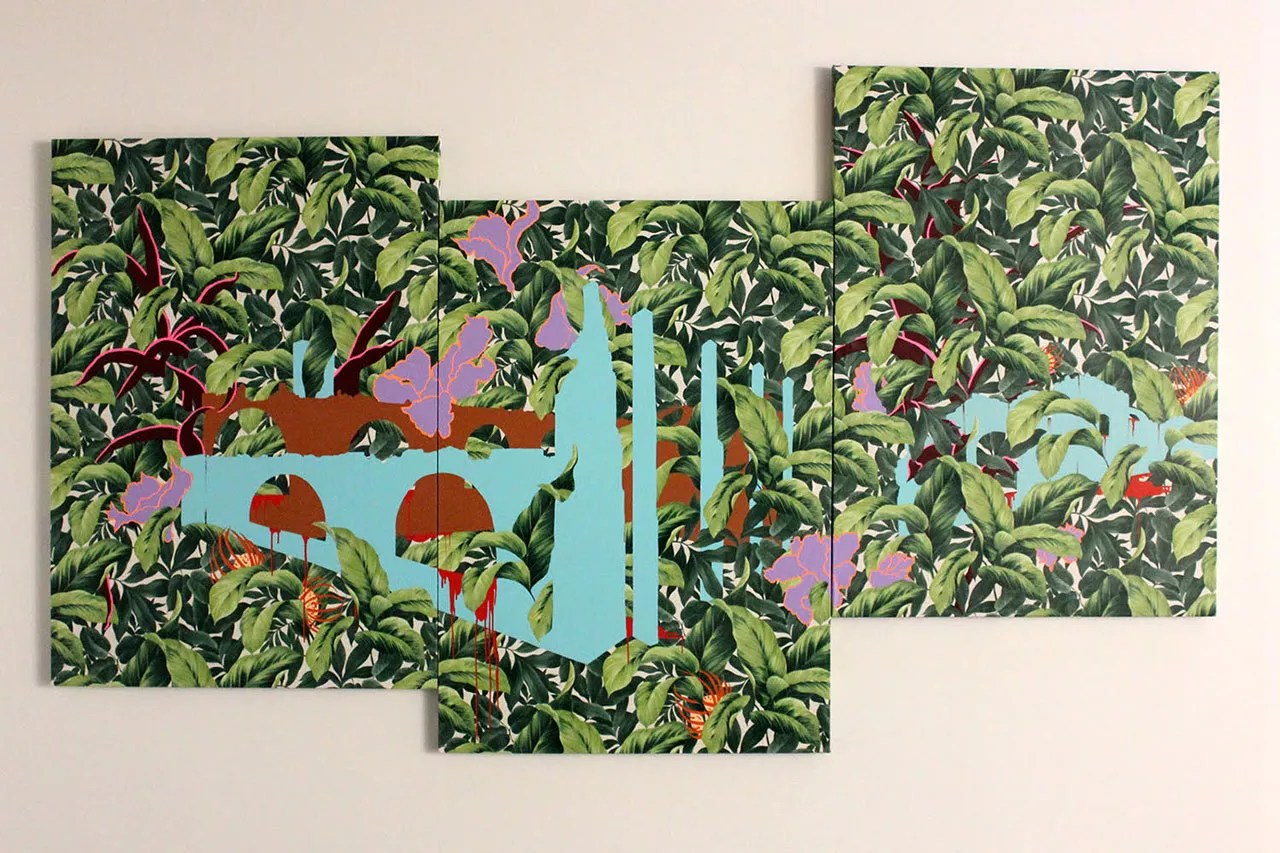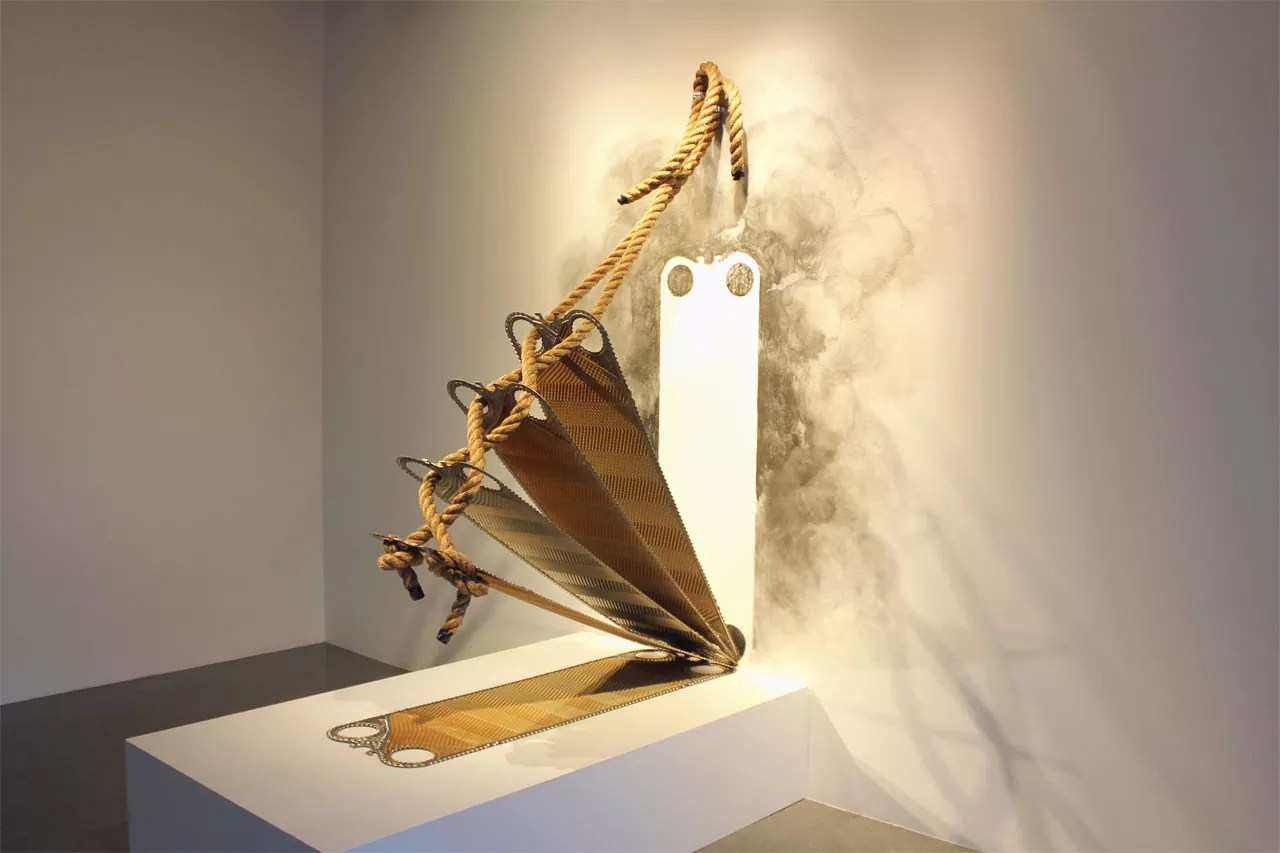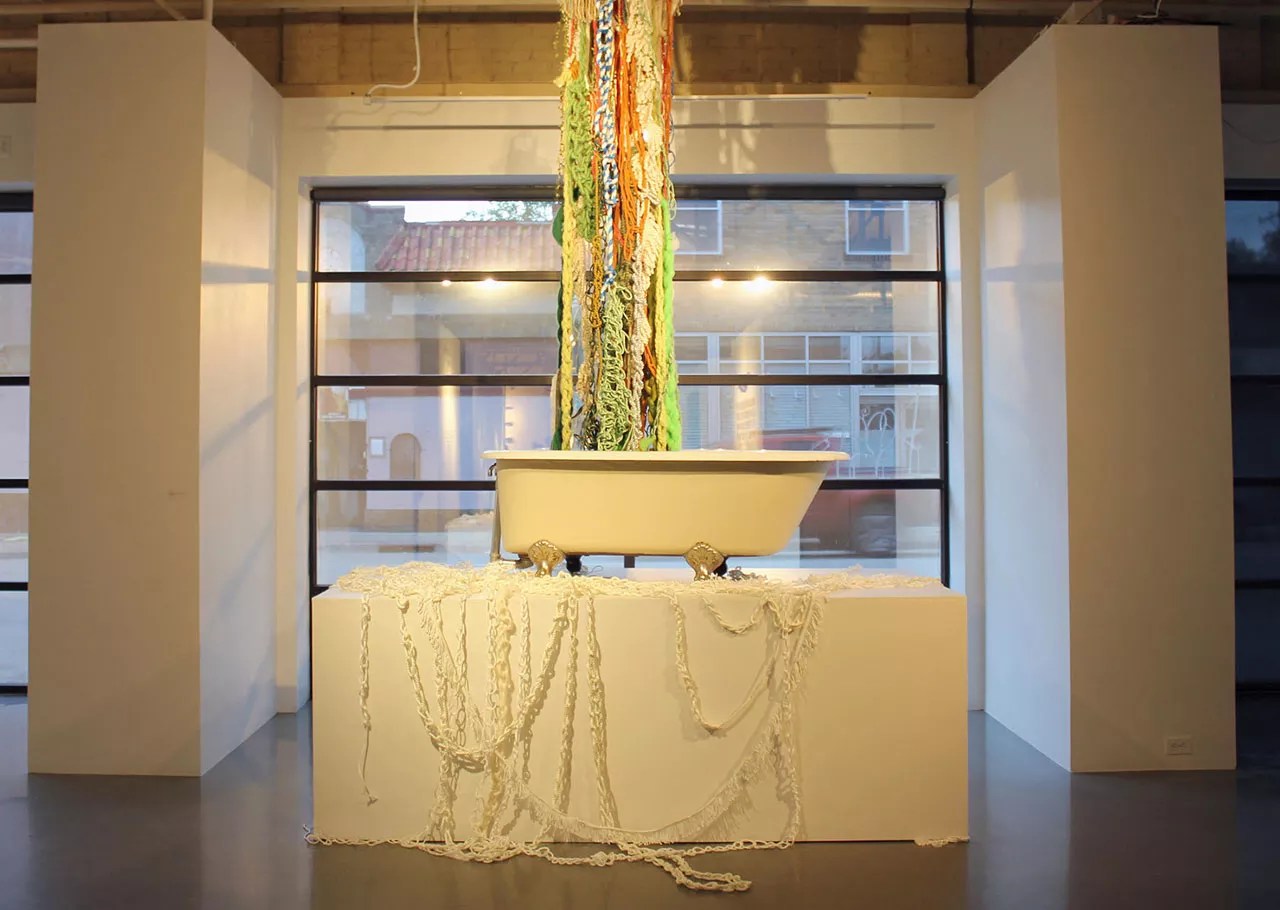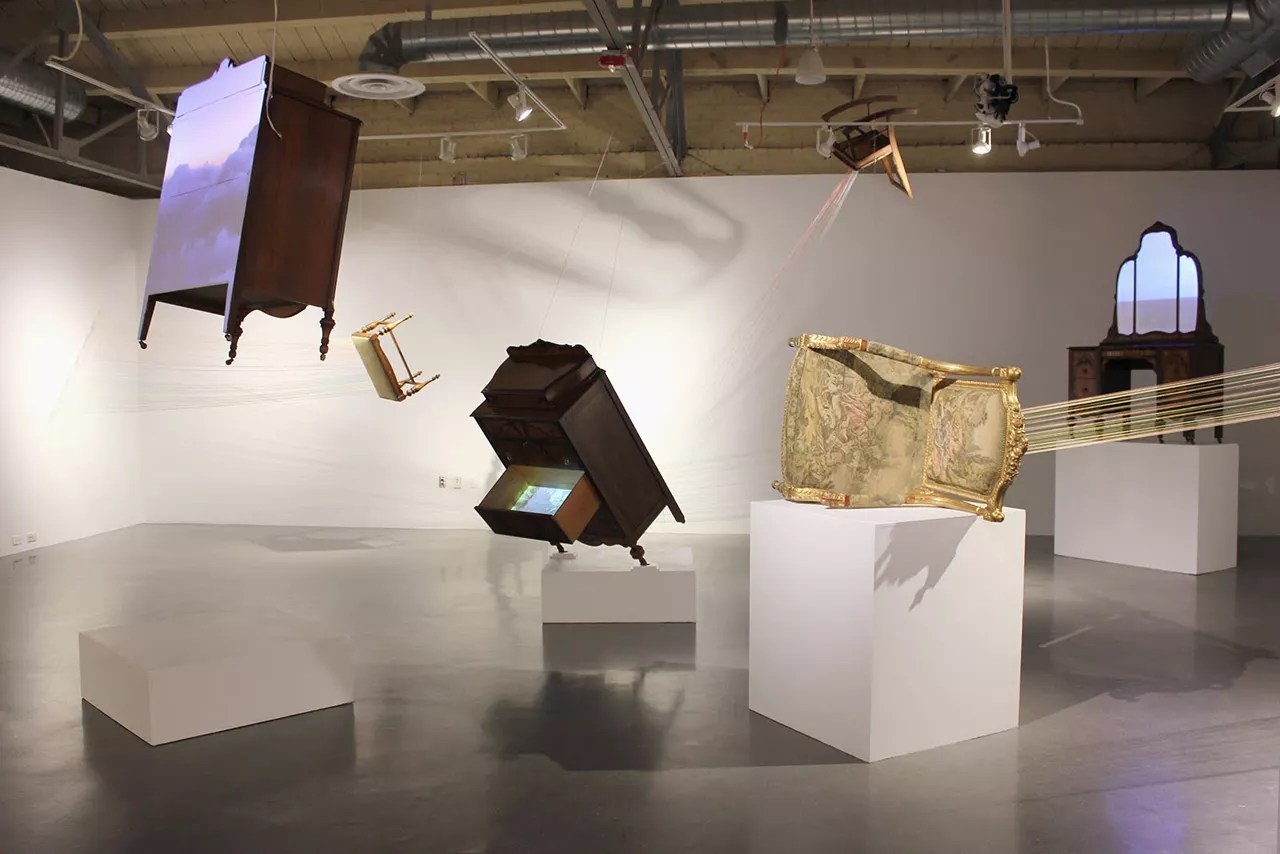
Heather Link-Bergman

Audio By Carbonatix
Metro State’s Center for Visual Art has devoted its entire set of galleries to Sugar Bound :: Suchitra Mattai, a sprawling solo by mid-career Denver artist Suchitra Mattai that includes her distinctive installations, paintings and fiber works, along with a few videos. Although these pieces are closely related in attitude and appearance to those Mattai displayed at K Contemporary earlier this year, they were all created specifically for Sugar Bound.
The show was curated by CVA director Cecily Cullen, who also did the exhibition design. As usual, it looks great.
Mattai is interested in exploring her heritage and using it to raise broader cultural, social and political issues. That heritage is complex: In the nineteenth century, her ancestors left India for Guyana to work as indentured servants on a sugar plantation. This genealogical detail inspired the show’s title, since Mattai’s forebears were literally bound to sugar in order to make their living. Her family emigrated to Canada when she was a small child, and she grew up there, coming to the U.S. to attend college and then moving to Denver ten years ago.

Heather Link-Bergman
She uses the clash, conflation and compression of these components of her personal history to set up the content of her conceptual pieces, which touch on everything from European imperialism to the exploitation of colonized people and the travails of the immigrant experience. Mattai also includes collapsing time in the mix, as Cullen notes. The concerns she raises based on nineteenth-century narratives are extremely relevant today, given what’s been happening at our southern border, where brown-skinned asylum seekers are denied entry to this country and, worse, separated from their children. The key source of Mattai’s inspiration is the relationship of the white oppressor to the non-white oppressed. She expresses all this mostly using found materials, particularly textiles, that she buys at junk shops or on the Internet, then alters and organizes into her striking creations. Mattai’s grandmother worked as a seamstress in Guyana, and the artist’s interest in needlework and knitting can be traced back to her.
Denver, make your New Year’s Resolution Count!
We’re $12,000 away from reaching our $50,000 year-end fundraising goal. Your support could be what pushes us over the top. If our work has kept you informed and connected this year, please consider making a contribution today.
The show gets off to a strong start with the installation “Purity test,” in which a “shower” of tied, twisted and crocheted yarn mounted on an armature suspended from the ceiling creates the suggestion of falling water flowing into an actual bathtub, one of those old-fashioned ones with claw feet. The bathing reference relates to the racist idea that non-white people are dirty and must be cleaned and thus purified. But the work’s title refers to another racist conceit, that of racial purity: Colonized peoples were regarded as impure, and thus inferior, because they were not descended from Europeans. Many of the other works in the show use similarly recognizable objects in combinations that reinforce Mattai’s conceptual efforts to deconstruct prejudice.

“Purity test,” by Suchitra Mattai, found materials.
Heather Link-Bergman
Much more abstract is another installation, “Bound,” a series of flat metal sheets that had originally been stamped to make radiator parts but were then scrapped. The sheets are suspended in a bellows-like sequence, held together by the kind of heavy rope you’d use to tie a boat. The form suggests a machine, implying movement, but the rope establishes that the contraption is static. The imagery is clear: The exploited laborer, an indentured servant in the context of this show, is bound to the job. Combined with “Purity test,” “Bound” suggests how dirty the plantation’s field hands would get in the normal course of their work.
Similar issues are raised by the triptych “Salvation islands.” Instead of canvas, Mattai has stretched a patterned vintage fabric to serve as the ground of the painting. The pattern is an all-over arrangement of large green leaves, an evocation of the American idea of a tropical paradise. To undercut that dreamy impression, she adds down-to-earth content about the reality of colonial life by painting an old island prison that peeks out from among the beautiful leaves. The Caribbean island prison, Mattai points out, was similar to the slave castles in Africa where captured people were held before being sent overseas in bondage.

Heather Link-Bergman
In “Clearing,” a painting that’s applied directly to the wall, Mattai deals with the exploitation of colonized land, depicting the clear-cutting of a tropical forest. The contours of the landscape are sketched out in white and yellow on a rich gray ground. Then, using a runny white paint that drips freely below the imagery, Mattai painted fallen logs in the foreground, while trees that are still standing fill the background. So you can add the environment to the concerns the artist addresses here.
The show reaches a climax in the back gallery, which is completely dedicated to an enormous installation, “Sugar water,” made up of antique bedroom furniture, chairs and video projections. Several pieces of the furniture, including a dresser that seems to float above our heads, are suspended by thin wires from the ceiling; some are connected to the walls with rainbow-colored yarn. Others, like a big gold chair, have been knocked over. It looks like the room is exploding. Videos of landscapes are projected onto some of the elements, such as the vanity’s three-part mirror, whose glass has been replaced with white panels. “Sugar water” captures the immigrant experience: In a physical sense, it refers to having to move furniture from place to place, but metaphorically, it has to do with the disconnections, displacements and disorientations inherent in someone leaving their home country for a potentially hostile one – hence the destruction suggested by the “flying” furniture.

“Sugar water,” installation by Suchitra Mattai, found furniture, video projections and yarn.
Heather Link-Bergman
There are a lot of significant shows competing for our attention right now, many of them reflecting the increasingly important role that women are playing in the contemporary art world after breaking through decades-old sexist barriers. The Kirkland Museum is highlighting the work of mid-century modernist Elizabeth Yanish Shwayder, a pioneer of contemporary sculpture in the state. The Ent Center for the Arts in Colorado Springs is hosting an extensive solo celebrating the accomplishments of Linda Fleming, who is associated with the Libre artist community. And this week, the Arvada Center will open a major retrospective of a half-century’s worth of paintings from the oeuvre of Virginia Maitland downstairs, and upstairs, a quartet comprising the work of Patricia Aaron, Jennifer Ivanovic, Sue Oehme and Jodi Stuart, plus an installation by Laura Merage. But the ambitious Sugar Bound, Mattai’s largest and most significant show, more than holds its own.
Sugar Bound :: Suchitra Mattai, through October 20, MSUD Center for Visual Art, 965 Santa Fe Drive, 303-294-5207, msudenver.edu/cva.